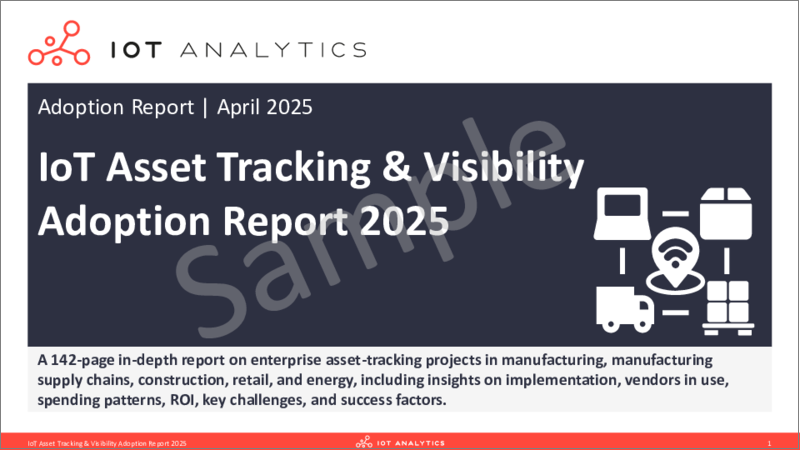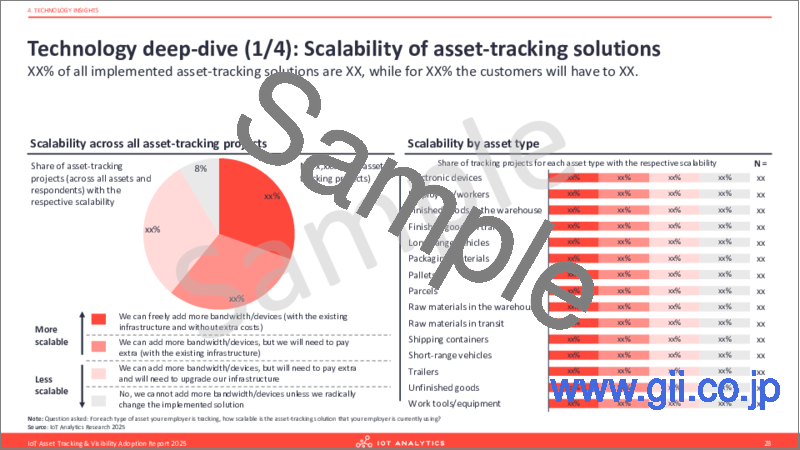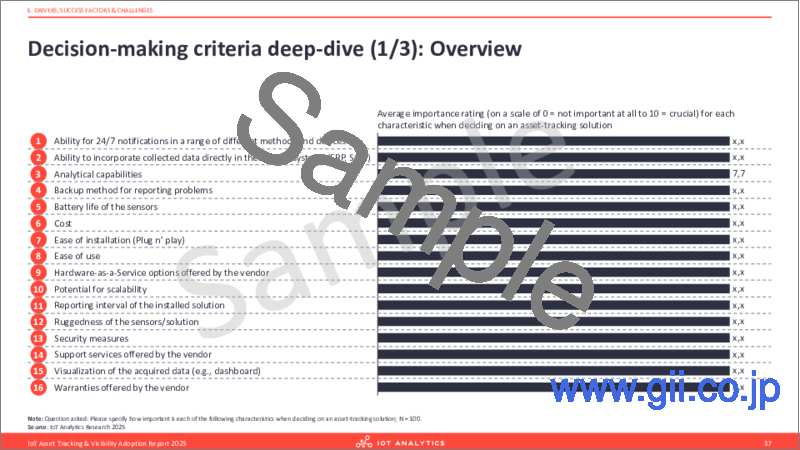|
|
市場調査レポート
商品コード
1697452
IoT資産追跡・可視化:導入レポート (2025年)IoT Asset Tracking & Visibility Adoption Report 2025 |
||||||
|
|||||||
| IoT資産追跡・可視化:導入レポート (2025年) |
|
出版日: 2025年04月07日
発行: IoT Analytics GmbH
ページ情報: 英文 142 Pages
納期: 即日から翌営業日
|
全表示
- 概要
- 目次
当レポートは、IoT Analyticsが継続的に発行している以下の調査レポートの一部であり、製造業、小売業、建設業における資産追跡ソリューションの導入企業100社を対象とした広範な調査に基づいています。
当レポートは、IoT Analyticsによるデータ中心の市場調査出版物です。IoTベースの資産追跡・可視化ソリューションの実際の採用状況を調査しています。意思決定者100人を対象とした調査に基づき、GPS、RFID、IoTセンサーなどの技術を使用して企業がどのように物理的資産を追跡しているかを調査しています。導入レベル、追跡対象資産の種類、ベンダーの関与、業界横断的な支出パターンを明らかにし、Cレベルの経営幹部や戦略担当者にベンチマーキングのための包括的な参照ポイントを提供します。
サンプルビュー


サンプルビュー


回答された質問:
- もっとも追跡されている資産は何で、各資産について何が追跡されているか?
- 資産追跡ソリューションによってどのような使用事例が可能になるか?
- もっとも使用されているトラッキング技術は何か、またトラッキングソリューションと統合されている企業システムはどれか?
- 導入されているソリューションの拡張性/統合性、データ転送/分析方法は?
- もっとも利用されているベンダーとその顧客満足度は?
- 市場における個々のベンダーの強みと弱みは何か?
- 導入企業はどのように資産追跡ソリューションを選択しているか?
- 導入時にどのような課題に直面したか、また導入成功の秘訣は何か?
- 企業は導入からどのようなROIを得たか、またそれは期待にどのように応えたか?
- 2025年にはどのような展開が予想されるか?
掲載企業
|
|
|
|
目次
第1章 エグゼクティブサマリー
第2章 イントロダクション
第3章 資産追跡の現状
- 1.概要・重要ポイント
- 2.資産追跡の概要
- 3.医薬品および食品・飲料業界における資産追跡の促進要因:コールドチェーン
- 4.追跡対象資産の種類
- 5.追跡の例:生産中の未完成品
- 6.追跡の例:従業員/労働者
- 7.追跡の例:小包
- 8.追跡対象資産の数
- 9.資産属性の追跡
- 10.温度の追跡
- 11.使用状況の追跡
- 12.資産追跡のユースケース:全体
- 13.資産追跡のユースケース:資産タイプ別
- 14.資産追跡のユースケース:地域別、企業規模別
- 15.資産追跡のユースケース:業界別
第4章 技術の洞察
- 1.概要・重要ポイント
- 2.接続技術:概要
- 3.接続技術:資産タイプ別
- 4.輸送コンテナの追跡:Hapag Lloydは衛星と携帯電話の技術を組み合わせて使用
- 5.資産追跡をサポートするソフトウェアとプラットフォーム:概要
- 6.資産追跡をサポートするソフトウェアとプラットフォーム:資産タイプ別
- 7.プラットフォームの例:SAP ERPへの統合
- 8.プラットフォームの例:OracleのEAM資産管理ソリューション
- 9.プラットフォームの例:Verizonのフリート管理ソリューションConnect Reveal
- 10.技術のハイライト:概要
- 11.技術の深掘り:資産追跡ソリューションの拡張性
- 12.技術の深掘り:企業システムとの統合
- 13.追跡プロジェクトの成功に影響を与える統合
- 14.技術詳細:データトランスミッション周波数
- 15.追跡プロジェクトの成功に影響を与えるデータトランスミッション周波数
- 16.技術の深掘り:資産追跡データの緊急性分析
第5章 ベンダーの洞察
- 1.概要・重要ポイント
- 2.もっとも多く言及された資産追跡ベンダー10社:概要
- 3.もっとも多く言及された資産追跡ベンダー10社:満足度と期待
- 4.もっとも多く言及された資産追跡ベンダー10社:追跡対象資産別
- 5.回答者が取引したすべてのベンダーの詳細なリスト
- 6.主要ベンダーの接続技術と提供ハードウェア
- 7.概要:ベンダーの強みと弱み
- 8.意見の深掘り:ベンダーの強み
- 9.意見の深掘り:ベンダーの弱点
- 10.意見の深掘り:ベンダー:SAP、社内、Oracle
- 11.意見の深掘り:ベンダー:IBM、Microsoft、Honeywell、Zebra、Samsara
- 12.意見の深掘り:ベンダー:Verizon、Project44、Asset Panda
第6章 促進要因・成功要因・課題
- 1.概要・重要ポイント
- 2.概要:資産追跡の実装の促進要因と意思決定基準
- 3.資産追跡ソリューションの主な意思決定基準:地域、業界、企業規模別
- 4.資産追跡ソリューションの主な意思決定基準:詳細業界別
- 5.意思決定基準の詳細:概要
- 6.例:資産追跡ソリューションのコスト
- 7.例:既存システムへのデータの組み込み
- 8.意思決定基準の詳細:地域、業種、規模別
- 9.意思決定基準の深掘り:詳細業界別
- 10.資産追跡ソリューションを実装する際の目標:概要
- 11.資産追跡ソリューションの導入の目的:詳細業界別
- 12.例:特定の企業が資産追跡の目標を達成した方法
- 13.資産追跡の実装における課題:概要
- 14.資産追跡の実装における課題:XX
- 15.支出・ROI・2025年の事業展望:概要・主なポイント
- 16.資産追跡支出:概要
- 17.資産追跡支出:資産タイプ別
- 18.資産追跡支出:詳細業界別
- 19.資産追跡ソリューションのROI:概要
- 20.資産追跡ソリューションのROI:セグメント別、追跡対象資産別
- 21.資産追跡ソリューションのROIが高い理由
第7章 支出・ROI・2025年の事業展望
- 1.資産追跡の実装結果:概要
- 2.資産追跡の実装結果:セグメント別・資産タイプ別
- 3.資産追跡の実装結果:資産タイプ別の詳細
- 4.2025年の支出見通し:概要
- 5.2025年の支出見通し:詳細業種別
- 6.2025年の支出見通し:資産タイプ別
- 7.支出増加の5つの主な要因(回答者のコメントに基づく)
- 8.支出増加の理由
第8章 調査手法
第9章 付録
第10章 IoT Analyticsについて
A 142-page report on enterprise asset-tracking projects in manufacturing, mfg. supply chains, construction, retail, energy, incl. insights on implementation, vendors in use, spending patterns, ROI, challenges, and success factors.
The "IoT Asset Tracking & Visibility Adoption Report 2025" is part of IoT Analytics' ongoing coverage of the IoT in general. The information presented in this report is based on an extensive survey of 100 adopters of asset-tracking solutions in the manufacturing, retail, and construction industries. The purpose is to inform other market participants about the current state of asset tracking across companies. Survey participants were selected randomly, and their knowledge was verified independently. To ensure complete objectivity, IoT Analytics did not alter or supplement any survey results and did not accept participants who were suggested by third parties (e.g., customers from specific vendors)-and where it's heading.
SAMPLE VIEW


Understand the current state of IoT asset tracking adoption
The "IoT Asset Tracking & Visibility Adoption Report 2025" is a data-centric market research publication by IoT Analytics. It explores the real-world adoption of IoT-based asset tracking and visibility solutions. Based on a global survey of 100 qualified decision-makers, the report investigates how companies track physical assets using technologies like GPS, RFID, and IoT sensors. It highlights adoption levels, tracked asset types, vendor involvement, and spending patterns across industries, offering C-level executives and strategists a comprehensive reference point for benchmarking.
SAMPLE VIEW


Structured analysis across key areas of asset tracking
The report is organized into clearly defined chapters, each covering a specific aspect of IoT-based asset tracking and visibility adoption:
- Executive summary. Highlights of the key findings and conclusions from the survey analysis.
- Introduction. Context and definitions, including the scope of asset types, environments, and visibility goals.
- State of asset tracking. Examines which assets are tracked, how many, which attributes are monitored, and the implementation footprint across use cases.
- Technology insights. Reviews tagging technologies, connectivity protocols, software platforms, integration levels, and data transmission frequency.
- Vendor insights. Details which solution providers are used, customer satisfaction levels, and vendor strengths/weaknesses.
- Drivers, success factors & challenges. Covers project goals, implementation bottlenecks, and best practices.
- Spending, ROI & business outlook 2025. Discusses current and planned investment levels, ROI findings, and future expectations.
- Methodology and appendix. Outlines survey methodology, respondent demographics, and additional charts.
Insights into what companies are doing in the field
The report provides a detailed snapshot of how companies are applying IoT-based asset tracking today. Based on end-user input, it allows market participants to understand what is being tracked, how it is being tracked, and why:
- Asset types and tracked data. Understand which assets are being monitored and what attributes-like location, temperature, or vibration-are tracked by end-users.
- Scale of deployment. See how many assets are currently tracked per type and what share of total assets companies aim to monitor in full rollouts.
- Technology and integration. Learn which connectivity technologies and sensor types are used in practice, how often data is transmitted, and how tracking systems are integrated into enterprise platforms like ERP or inventory management.
- Software and use cases. Discover which software platforms support tracking and what use cases-such as theft prevention, predictive maintenance, or inventory optimization-are actively enabled by users.
- Vendor landscape. Identify which solution providers are being used, what parts of the solution they deliver, and how satisfied users are with their performance.
- Spending and ROI. Benchmark how much companies are spending annually, how budgets are expected to change in 2025, and what levels of ROI are achieved across asset types.
- Implementation realities. Gain insight into how end-users select solutions, handle time-sensitive data, overcome deployment challenges, and what they cite as key success factors.
A downloadable sample of the report is available to preview the structure, explore example insights, and assess the data depth. It provides a grounded foundation for organizations looking to benchmark or plan their IoT asset tracking initiatives.
Questions answered:
- Which are the most tracked assets and what is being tracked for each asset?
- Which use cases are enabled from asset-tracking solutions?
- Which are the most used tracking technologies, and which company systems are integrated with the tracking solution?
- How scalable/integrated are the implemented solutions, and how is the data transmitted/analyzed?
- Which are the most used vendors, and how satisfied are their customers?
- What are the strengths and weaknesses of individual vendors in the market?
- How are adopters selecting asset-tracking solutions?
- What challenges did they face when implementing, and what tips do they have for a successful implementation?
- What ROI have companies seen from their implementations, and how did this meet their expectations?
- How much are companies spending on asset tracking and how is that spending expected to develop in 2025?
Companies mentioned:
A selection of companies mentioned in the report.
|
|
|
|
Table of Contents
1. Executive Summary
2. Introduction
- 1. What is Asset Tracking in the context of this report
- 2. Asset tracking plays a crucial role in companies' supply chains
- 3. Going into 2025, supply chain is one of the main topics for CEOs
- 4. The interest in search terms related to asset tracking and supply chain is slowly growing
- 5. Companies with a focus on asset tracking are seeing the results of that interest
- 6. There are many reasons why companies adopt IoT asset-tracking solutions
- 7. The report is segmented into 5 chapters
- 8. The report analyzes 15 different asset types
- 9. ... and 10 technologies used for asset tracking...
- 10. ... based on a survey of 100 end-users of asset-tracking solutions
- 11. Examples of companies who participated in the research
3. State of asset tracking
- 1. Chapter 3: State of asset tracking - Overview and key takeaways
- 2. Asset tracking overview
- 3. What is driving asset tracking in the Pharma and F&B industries: Cold chains
- 4. Types of assets tracked
- 5. Tracking examples: Unfinished goods in production - Example: Denchi tracks unfinished batteries in production using barcodes.
- 6. Tracking examples: Employees/workers - Example: Salco tracks workers using a UWB solution.
- 7. Tracking examples: Parcels - Example: Altru tracks parcels using Bluetooth-enabled sensors.
- 8. Number of assets tracked
- 9. Asset attributes tracked
- 10. Tracking temperature: Sensitech provides a platform to see asset temperature over time and accepted ranges
- 11. Tracking Utilization: Samsara provides special "Utilization Reports" that show how often assets are used
- 12. Asset tracking use cases: Overall
- 13. Asset tracking use cases: By asset type
- 14. Asset tracking use cases: By region, and company size
- 15. Asset tracking use cases: By industry
4. Technology insights
- 1. Chapter 4: Technology insights - Overview and key takeaways
- 2. Connectivity technologies: Overview
- 3. Connectivity technologies: By asset type
- 4. Tracking shipping containers: Hapag Lloyd uses a mix of satellite and cellular technologies
- 5. Software and platforms that support asset tracking: Overview
- 6. Software and platforms that support asset tracking: By asset type
- 7. Platform example: Integrating into SAP ERP
- 8. Platform example: Oracle's EAM Asset Management solution
- 9. Platform example: Verizon's Fleet Management solution "Verizon Connect Reveal"
- 10. Technology highlights: Overview
- 11. Technology deep-dive: Scalability of asset-tracking solutions
- 12. Technology deep-dive: Integration with company systems
- 13. Integration affecting success of tracking projects
- 14. Technology deep-dive: Data transmission frequency
- 15. Data transmission frequency affecting success of tracking projects
- 16. Technology deep-dive: Analysis urgency of asset tracking data
5. Vendor insights
- 1. Chapter 5: Vendor insights - Overview and key takeaways
- 2. 10 most mentioned asset-tracking vendors: Overview
- 3. 10 most mentioned asset-tracking vendors: Satisfaction & expectations
- 4. 10 most mentioned asset-tracking vendors: By asset tracked
- 5. Extensive list with all vendors that respondents have worked with
- 6. Connectivity technologies and hardware offerings of select vendors
- 7. Overview: Vendor strengths and weaknesses
- 8. Opinion deep dives: Vendor strengths
- 9. Opinion deep dives: Vendor weaknesses
- 10. Opinion deep dives: By vendor: SAP, in-house, and Oracle
- 11. Opinion deep dives: By vendor: IBM, Microsoft, Honeywell, Zebra, Samsara
- 12. Opinion deep dives: By vendor: Verizon, Project44, Asset Panda
6. Drivers, success factors & challenges
- 1. Chapter 6: Drivers, success factors & challenges - Overview and key takeaways
- 2. Overview: Asset-tracking implementation drivers & decision-making criteria
- 3. Top decision-making criteria for asset-tracking solutions: By region, industry, and company size
- 4. Top decision-making criteria for asset-tracking solutions: By detailed industry
- 5. Decision-making criteria deep-dive: Overview
- 6. Example: Cost of asset-tracking solutions
- 7. Example: Incorporating data in existing systems
- 8. Decision-making criteria deep-dive: By region, industry, size
- 9. Decision-making criteria deep-dive: By detailed industry
- 10. Goals when implementing an asset-tracking solution: Overview
- 11. Goals when implementing an asset-tracking solution: By detailed industry
- 12. Examples: How specific companies achieved their asset tracking goals
- 13. Challenges when implementing asset tracking: Overview
- 14. Challenges when implementing asset tracking: XX
- 15. Chapter 7: Spending, ROI & business outlook 2025 - Overview and key takeaways
- 16. Asset-tracking spending: Overview
- 17. Asset-tracking spending: By asset type
- 18. Asset-tracking spending: By detailed industry
- 19. ROI of asset-tracking solutions: Overview
- 20. ROI of asset-tracking solutions: By segment and asset tracked
- 21. Reasons for a high ROI of an asset-tracking solution
7. Spending, ROI & business outlook 2025
- 1. Results of asset-tracking implementations: Overview
- 2. Results of asset-tracking implementations: By segment and asset type
- 3. Results of asset-tracking implementations: By asset type detailed
- 4. Spending outlook for 2025: Overview
- 5. Spending outlook for 2025: By detailed industry
- 6. Spending outlook for 2025: By asset type
- 7. 5 key drivers of higher spending (based on respondent comments)
- 8. Reasons for increased spending






